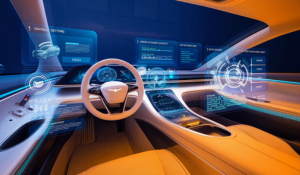As automobiles become increasingly connected and software-driven, the importance of automotive cybersecurity has never been more critical. With the rise of connected vehicles and autonomous driving technologies, the automotive industry faces new cybersecurity challenges to ensure the safety, privacy, and integrity of these advanced systems.
In this blog post, we will delve into the world of automotive cybersecurity standards and regulations, examining their significance in safeguarding vehicles from cyber threats.
What is ISO/SAE 21434?
Developed jointly by the International Organization for Standardization (ISO) and the Society of Automotive Engineers (SAE), ISO/SAE 21434 specifically addresses automotive cybersecurity by aiming to provide a consistent and robust approach to managing cybersecurity risks in vehicles.
ISO/SAE 21434 establishes guidelines and requirements for the automotive development lifecycle, including design, production, and post-production activities. It emphasizes the importance of risk management and secure development practices to identify and mitigate potential cybersecurity threats.
What are the key sections of ISO/SAE 21434?
The key sections of ISO/SAE 21434 include:
Risk Management: This section focuses on the identification and assessment of cybersecurity risks throughout the vehicle's lifecycle. It involves:
- Defining cybersecurity goals
- Conducting risk analysis
- Implementing appropriate risk mitigation measures
Secure Development: This section outlines the best practices for secure development, including:
- Secure coding guidelines
- Vulnerability assessments
- Secure software updates
What are other relevant automotive cyber security standards?
Apart from ISO/SAE 21434, several other notable automotive cybersecurity standards have emerged in recent years to address the unique challenges posed by connected vehicles. These standards include:
- SAE J3061: Developed by the Society of Automotive Engineers, SAE J3061 provides guidelines for automotive cybersecurity processes and methods. It emphasizes the need for a multi-layered defense strategy and promotes collaboration among stakeholders to enhance cybersecurity resilience.
- NHTSA Cybersecurity Best Practices: The National Highway Traffic Safety Administration (NHTSA) has released voluntary guidelines to assist automotive manufacturers in addressing cybersecurity risks. These guidelines focus on risk assessment, detection, and response to cybersecurity incidents.
The importance of collaboration
Effective automotive cybersecurity requires collaboration and coordination among various stakeholders, including automotive manufacturers, government agencies, and the cybersecurity community. Collaboration enables the sharing of knowledge, best practices, and threat intelligence, leading to a more robust defense against cyber threats.
Collaboration between the automotive industry and governments is essential in developing and implementing cybersecurity regulations that set industry standards and best practices. Additionally, partnerships with the cybersecurity community help identify emerging threats and vulnerabilities, enabling timely responses and proactive security measures.
Another noteworthy recent development: WP.29 and Regulation No. 155
Recent developments in automotive cybersecurity standards demonstrate the continuous evolution of the industry's security practices. One significant development is the United Nations Economic Commission for Europe (UNECE) World Forum for Harmonization of Vehicle Regulations (WP.29) requirements.
UN Regulation No. 155, established by the World Forum for Harmonization of Vehicle Regulations (WP.29), outlines cybersecurity requirements for the entire lifecycle of road vehicles. It mandates manufacturers to implement a cybersecurity management system (CSMS), conduct threat analysis and risk assessments during vehicle development, and create strategies to mitigate identified cybersecurity risks. The regulation also requires a process for monitoring, responding to, and learning from cybersecurity events, highlighting the importance of vehicle cybersecurity in an era of increased vehicle connectivity and autonomy.
The World Forum for Harmonization of Vehicle Regulations (WP.29), a working party in the institutional framework of the United Nations, has been a global forum for motor vehicle regulation discussions for over half a century. Its participants, coming from around the world, including major vehicle-producing nations, collaborate under a unique framework that facilitates globally harmonized regulations for vehicles.
The results of Regulation No. 155 and other WP. 29 regulations have made significant contributions to road safety, environmental protection, and international trade. Any United Nations member country or any regional economic integration organization established by United Nations member countries can participate fully in the World Forum's activities and potentially become a contracting party to the Agreements administered by the Forum.
Both governmental and non-governmental organizations can also participate in a consultative capacity in WP.29 or its subsidiary working groups. The World Forum, which meets officially three times per year, delegates specific, urgent problems or those requiring special expertise to informal groups. More than 120 representatives participate in the sessions of the World Forum. Upholding transparency, all agendas, working documents, and reports from the World Forum are openly accessible online.
Conclusion
Automotive cybersecurity is a critical aspect of the automotive industry, given the increasing connectivity and automation in vehicles. Standards and regulations play a vital role in guiding manufacturers to implement robust cybersecurity practices throughout the vehicle's lifecycle.
ISO/SAE 21434 provides a comprehensive framework for managing cybersecurity risks in vehicles, focusing on risk management and secure development. Other standards, such as SAE J3061 and NHTSA Cybersecurity Best Practices, complement ISO/SAE 21434 by offering additional insights and guidance.
Collaboration between the automotive industry, governments, and the cybersecurity community is essential for addressing emerging threats and establishing effective cybersecurity measures. Recent developments, including UNECE WP.29 requirements and data privacy regulations, highlight the ongoing efforts to strengthen automotive cybersecurity.
As the automotive industry continues to innovate, cybersecurity standards and regulations will play a pivotal role in ensuring the safety, security, and trustworthiness of connected and autonomous vehicles. By adhering to these standards and fostering collaboration, the industry can stay ahead of cyber threats and build a safer and more secure automotive ecosystem.
Subscribe to Our Blog
Get the latest posts delivered straight to your inbox weekly.
Share this
You May Also Like
These Related Stories

Navigating Automotive Compliance in the Age of Connected Devices

Exploring the Dept. of Commerce’s Proposed Rule for Connected Vehicles



